Note: This post contains spoilers.
There's still a lot of controversy about whether Deckard is a replicant in the movie Blade Runner. You can interpret the film as you like — and I have my own strong feelings about it — but I think costume design conveys a lot about what the original production team thought about the characters.
For this post, I won't be getting into the history of "Deckard is a replicant" except to say that's never been my interpretation of any version of the film, and Deckard is not an android in the Philip K. Dick novel from which Blade Runner was adapted.
What I'd like to lay out here is some evidence from the Blade Runner production design that appears to clearly delineate who is human and who is replicant. Or, more specifically, to delineate the "human-ness" of a character within a given scene.
The evidence I want to lay out here indicates that costuming within the film signifies where a character exists on a spectrum of human-versus-replicant. Human characters have been given costumes rich with color and texture. Replicants are costumed in shades of black, white, and gray. It's no more complex than that, and shifts in costuming seem intentionally used to indicate that the human-ness of some characters shifts along with certain points in the narrative.
Let's get to some examples. We'll move more or less along with the story since that approach best shows how some twists in the story are paralleled by changes in costuming.

We first meet Blade Runner Holden (in a beige or tan suit) giving the Voight-Kampff test to Leon (wearing all white).
Brown, earthy colors are quickly associated with cops here — humans who do dirty work.
Deckard (eating noodles) is wearing a brown overcoat, though with a maroon shirt peeking out. Bryant is wearing shades of beige and brown.
Gaff, like the others, wears a brown coat, but underneath: blue, pink, yellow/gold — intricate patterns, a rose on his lapel. Maybe the most vibrant palette of any character in the film. Is Gaff the most human, the most internally vibrant? He "knows" things, or intuits them, and leaves clues.
I suspect Gaff represents a chorus of sorts, commenting aside on what the actors on stage won't say. (And coincidentally, Gaff is a man of few words, but words that say volumes when he does speak.)
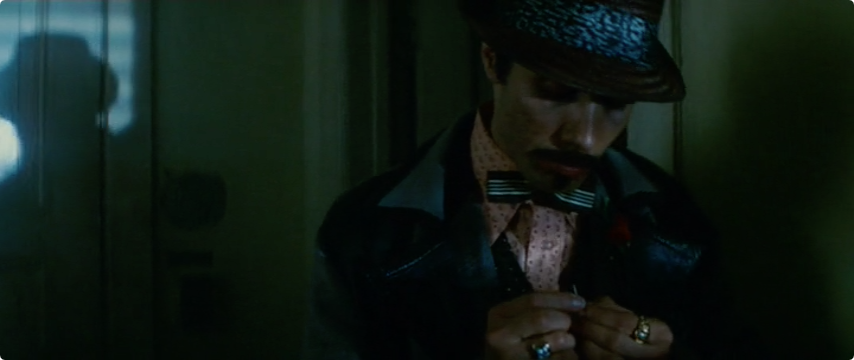
At the Tyrell offices, we meet Rachel. Black suit. Black hair. Pale, white skin.
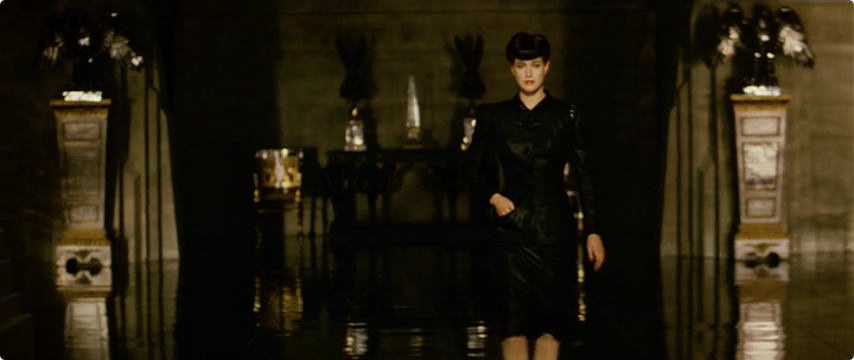
Rachel's bright red lipstick is an interesting touch. Is it meant to be a face Rachel puts on to appear more human? The use of makeup has some parallel moments later in the film, the crowd at Taffey's nightclub, Zhora, and Pris all wear makeup that could be interpreted as either hiding or accentuating their true identities.
Eldon Tyrell appears suddenly wearing sumptuous royal blue and white. I'll get back to the connection between Tyrell and his bright white wardrobe later....
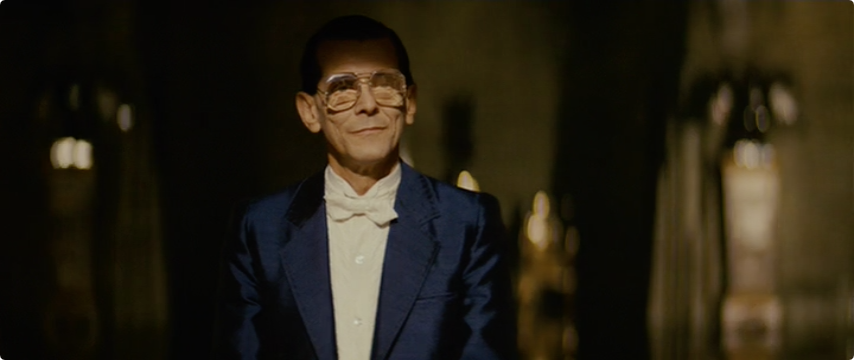
In this scene we get a closer look at Deckard's clothing: a brown sportcoat and trousers, but check out that shirt! Blue. Burgundy. Yellow or perhaps gold. And an intricate pattern across his shirt and tie.
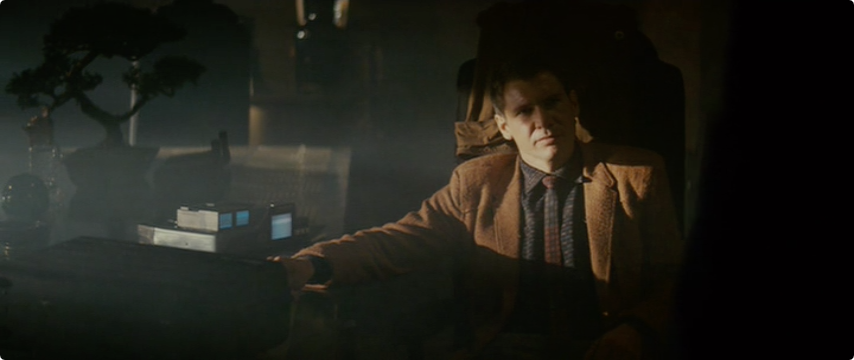
Abdul Ben Hassan, the snake merchant, wears a red, patterned tie and red fez against an immaculate white suit. (Again, we'll come back to the white later.)
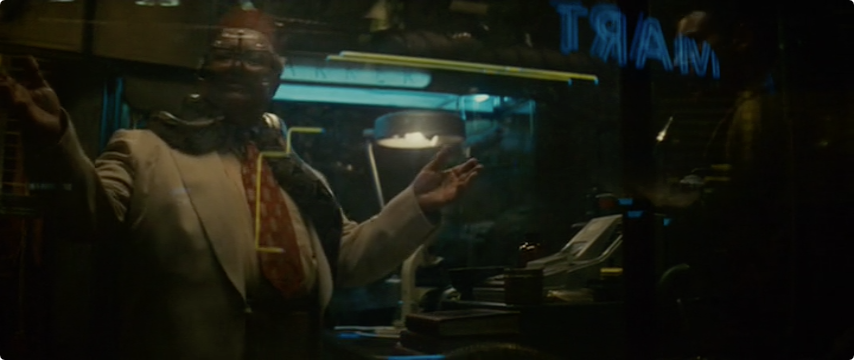
The first time we see J.F. Sebastian he's wearing a highly textural gold, green, and red jacket. Pris, in contrast, wears all black except for her white hair. Even her bag, boots, and makeup are black.
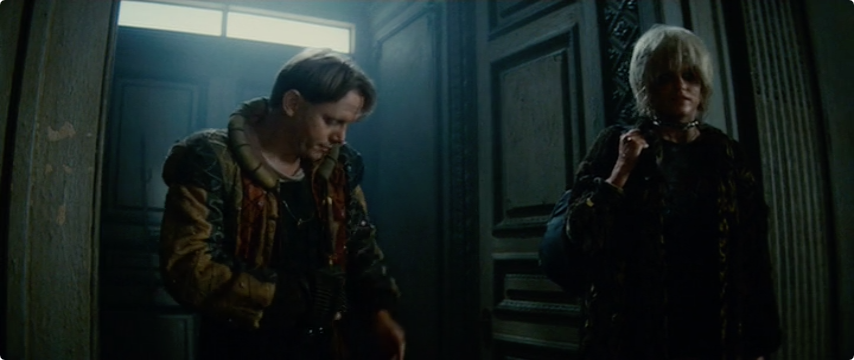
The contrast is even more obvious later when we see cleaned-up Pris with Roy: black, gray, and white.
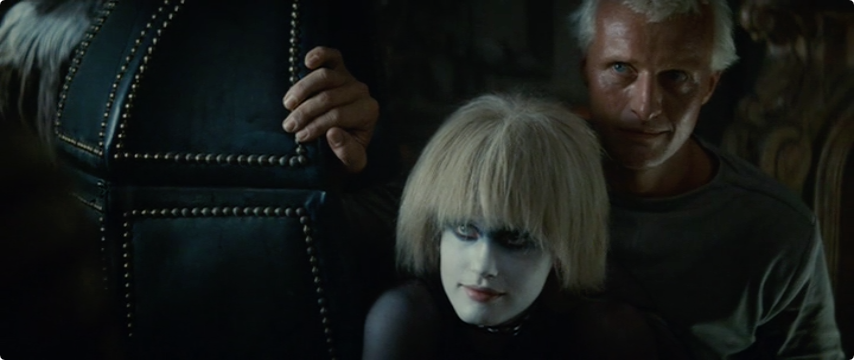
When Sebastian is with Roy and Pris ("We've got a lot in common"...) and reveals that his Methuselah Syndrome makes him unable to work off-world — less than fully human — he's removed his colorful jacket and is now wearing a white, gray, and black striped sweater.
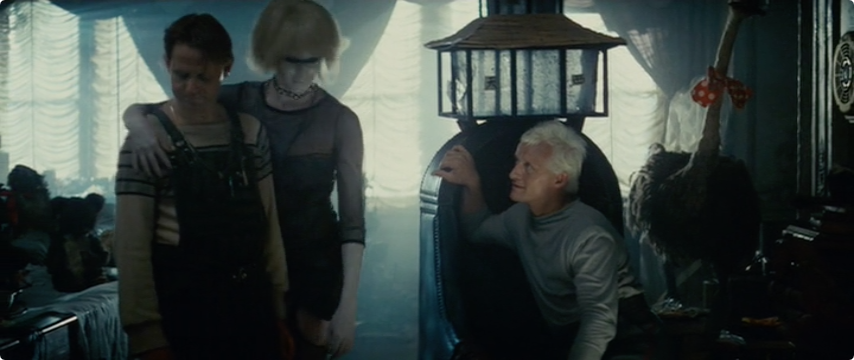
The scenes in which we see Taffey Lewis's nightclub are short, but interesting to see the bustle and color of human social life. I don't think we learn a lot from these scenes, but I do think the hair, hats, and makeup comment on the underlying humans-versus-androids thread:
- On the one hand, humans who have grown up with the freedom and experiences of a full life socialize in a colorful, vibrant, visually exciting environment. The costumes are amazing. Compare that to the quiet, childish, furtive social moments between the replicants.
- On the other hand, even the humans put on costumes, pretending and preening, perhaps trying to be someone at night much more interesting than during the day?
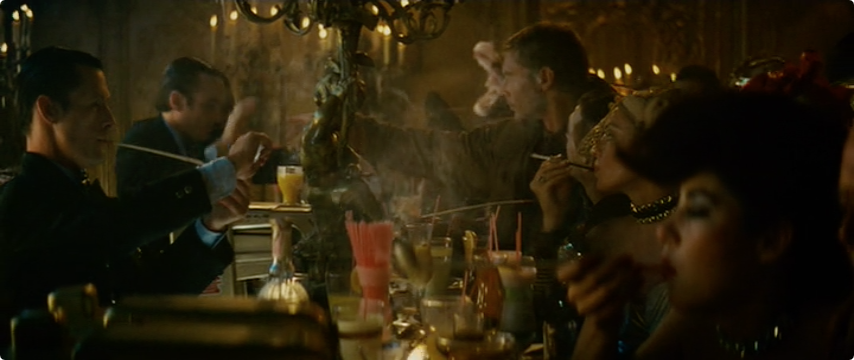
Within this vibrant scene: don't be fooled by Zhora's sparkles, she takes off her fake snake and silver sparkles, and changes into a (very scant) costume of black and clear!
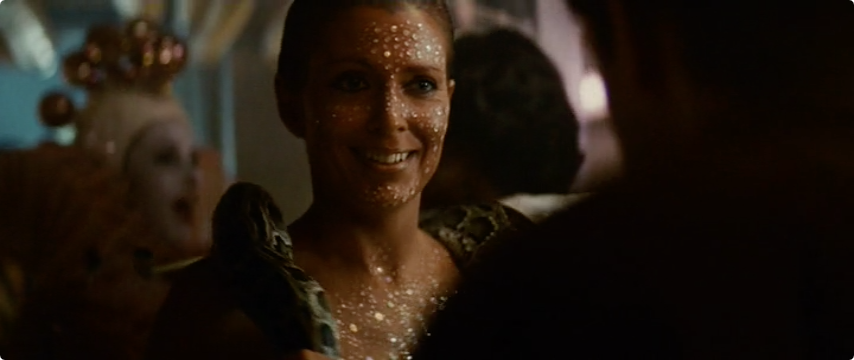
Rachel on the run, shows up at Deckard's apartment wearing a grayscale suit. Lips still red, but her makeup is coming off.
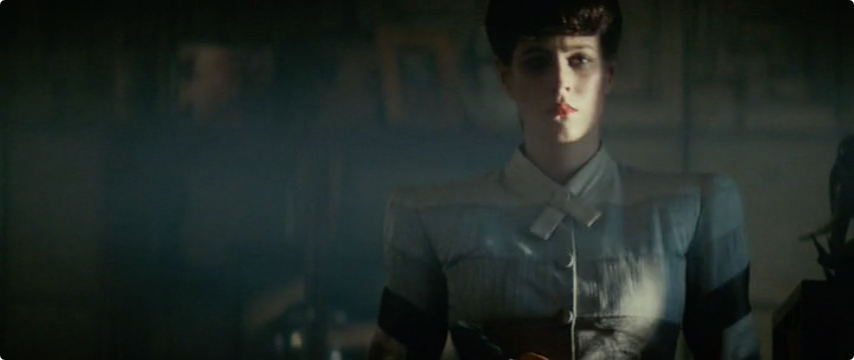
Deckard is having a tough day. We get a better look at his shirt of many colors, though.
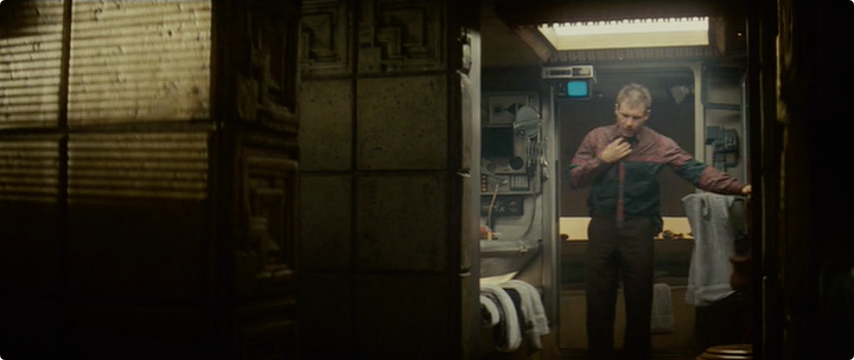
What's my point? In almost every scene, we see consistent costuming by which human characters are wearing colors and androids are wearing black, white, and gray.
- Leon (Tyrrell) - White
- Holden - Beige
- Deckard - Brown, Blue, Burgundy
- Gaff - Brown coat, but underneath: Blue, Pink, Yellow/Gold - Intricate patterns
- Bryant - Beige, Brown
- Tyrrell - Blue
- Rachael - Black
- Roy - Black, White
- Leon - Black
- Hannibal Chew - Brown, Gray, Yellow (Very muted colors in this scene)
- Rachael (Deckard's Apt) - Black
- Pris - Black, Silver, Gray, White - Pink makeup (like Rachel's lipstick?)
- Sebastian - Green, Red, Yellow
- Abdul Ben Hassan - Red, White
- Rachael (Phone) - White
- Taffey Lewis - Green, Blue, Red
- Zhora (Salome) - Silver
- Zhora - Black, Clear
- Deckard (Taffey's Bar) - Burgundy, Red, Yellow, Seagreen, Blue - Firebird pattern!
- Rachael (Street) - White, Gray
- Rachael (Deckard's Apt) - Grayscale
- Pris (Sebastian's Apt) - Black, White
- Roy - Black, Gray
- Sebastian - White, Gray, Black ("We've got a lot in common"...)
- Sebastian (Tyrrell's Room) - Brown, Red - Human again, appalled by Roy.
As I mentioned earlier, there's one potential contradiction, which is the white costumes worn by Adbdul Ben Hassan early in the film and Tyrell later in film. I think this use of white makes a different point, which is that of the holy creator. Both Hassan and Tyrell are, in a sense, gods, bringing life to their creations.
Note that in Tyrell's room, he references the prodigal son story from scripture, and the room is lit by candles, perhaps a reference to Prometheus or Icarus?
The white Tyrell costume in this scene also connects back to the first scene in which Leon appears to be wearing all white, and the white dove in Roy's final scene.
From a production design point of view, Blade Runner appears to have been created with the intent to portray Deckard as human. Over various cuts, attempts were made, apparently, to muddy those waters, but for me they don't hold up.
There's a lot more to discuss about this film. Perhaps in a future post I'll move on to what "human-ness" means in Blade Runner and how it plays with ideas common to some of my favorite Ridley Scott films: servitude, enslavement, and the inability to live fully under those circumstances.